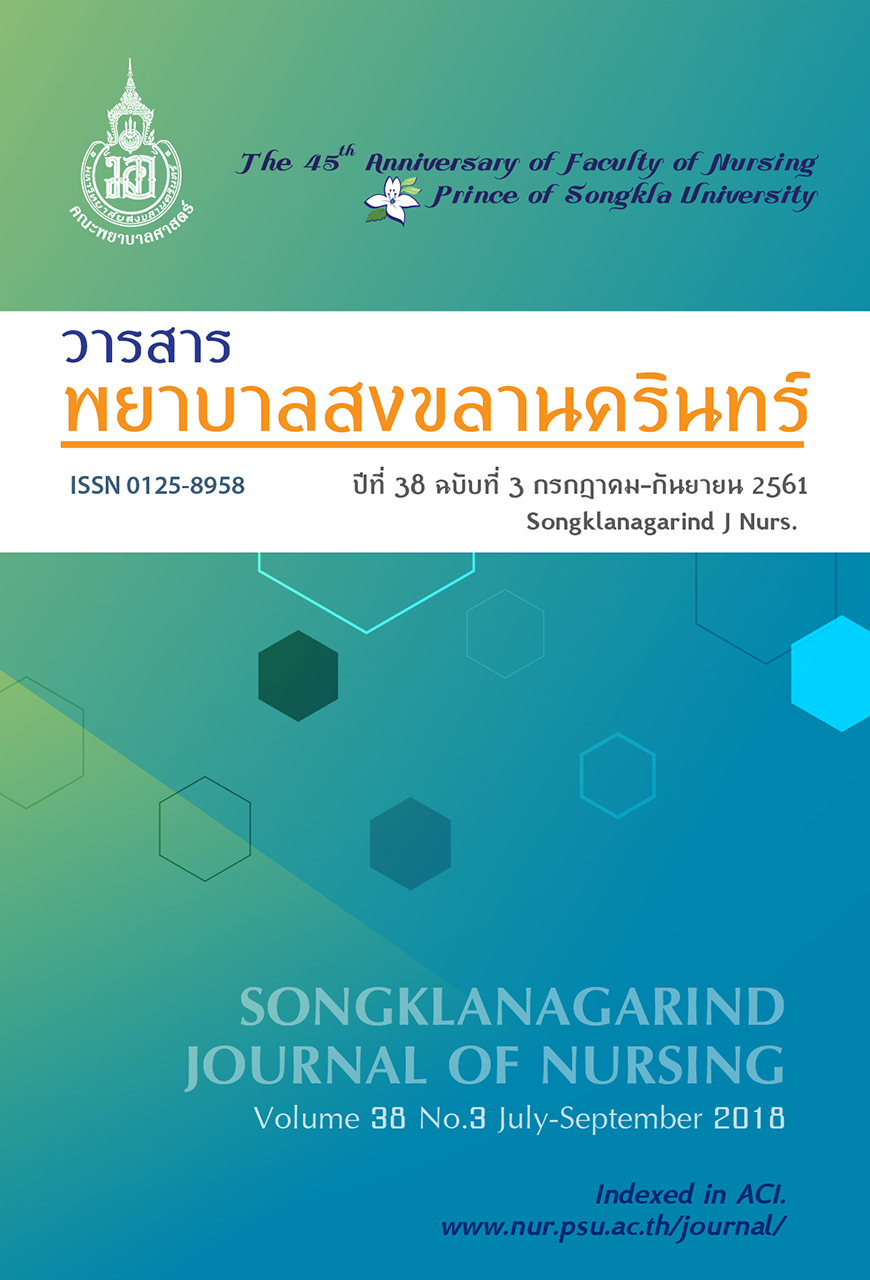Headache and Dizziness, Symptom Management, and Quality of Life of Patients with Mild Traumatic Brain Injury
Main Article Content
Abstract
This study aimed to examine headache and dizziness, symptom management of patients with mildtraumatic brain injury (TBI) and their quality of life. The sample consisted of 85 mild TBI patients who were admitted in hospital. A purposive sampling technique was used to select the sample in this study. Data were collected using a questionnaire consisted of three parts: Symptom after TBI, Symptom Management after TBI, and The Quality of Life after Brain Injury Overall Scale. Cronbach’s alpha was used to calculate
the reliability of the Questionnaire. The reliability was .81, .81 and .86, respectively. Data were analyzed using descriptive statistics. Nonparametric statistics, including Chi-square, The Wilcoxon Test and Fisher’s exact test.
The results showed that:
1. There were statistically significant difference on the frequency and the severity levels of the headache and the dizziness between hospitalization and one month after hospital discharge (χ2(2)=63.87, p< .001 and χ2(2)=20.18, p< .001, respectively and χ2(2)=40.47, p< .001 and χ2(2)=17.29, p< .001, respectively).
2. There were statistically significant differences on the frequency of symptom management of the headache and dizziness between hospitalization and one month after hospital discharge (Z=-4.19, p< .001;Z= -6.45, p< .001, respectively).
3. At the hospital, 90.5% of headache subjects were treated by bed rest. One month after discharge,79.7% of the subjects were treated with drugs for pain relievers management method. As for dizziness while in the hospital and one month after discharge, the most commonly used method of management was bed rest at 85.2%, and 84.8% respectively.
4. The overall quality of the subjects’ lives were 60% at a moderate level, 35.3% the lowest score , and 4.7% the highest level.
5 There was a significant correlation between subjects’ severity of dizziness and their quality of life at one month after hospital discharge (fisher’s exact test value=13.56, p< .01).
The findings of this study are information for headache and dizziness symptom management for nursing plan in mild traumatic brain injury patients during hospitalization and continuity of care in the patient’s home to improve their quality of life further.
Article Details
References
2. Medical Record Department. Maharaj Nakhon Si Thammarat Hospital. Maharaj Nakhon Si Thammarat Hospital: Statistical Report 2016. Nakhon Si Thammarat: Maharaj Nakhon Si Thammarat Hospital, 2016. Thai
3. McAllister TW, Arciniegas D. Evaluation and treatment of postconcussive symptoms. Neuro Rehabilitation. 2002;17(4):265-83.
4. Arciniegas DB, Anderson CA, Topkoff J, et al. Mild traumatic brain injury: A neuropsychiatric approach to diagnosis, evaluation, and treatment. Neuropsychiatr Dis Treat. 2005;1(4):311-27.
5. Fikriyanti KL, Songwathana P. The post concussion symptom experience and quality of life in Indonesia person with mild traumatic brain injury. Songkla-nagarind J Nurs. 2014;34(2):1-16. Thai.
6. Marshall S, Bayley M, McCullagh S, et al .Clinical practice guidelines for mild traumatic brain injury and persistent symptoms. Can Fam Physician. 2012;58(3): 257-67.
7. Mott TF, McConnon ML, Rieger BP. Subacute to chronic mild traumatic brain injury. AM FAM PHYSICIAN. 2012;86(11):1045-51.
8. Faux S, Sheedy J. A prospective controlled study in the prevalence of posttraumatic headache following mild traumatic brain injury. Pain Med. 2008;9(8): 1001-11. doi:10.1111/j.1526-4637.2007.00404.x
9. Hall RCW, Hall RCW, Chapman MJ. Definition, diagnosis, and forensic implications of post concussion syndrome. Psychosomatics. 2005;46(3):195-202. https://doi.org/10.1176/appi.psy.46.3.195
10. Kaenphet S. The post-concussion symptom experiences, symptom management and quality of life in clients with mild traumatic brain injury in the upper Southern Region. [dissertation].[Songkhla]: Prince of Songkla University; 2015.147 p. Thai.
11. Buranawanich W, Pearkao P. Quality of lifeand symtoms among adults after mild traumatic brain injury in Maharat Nakhonratchasima Hospital. Journal of Nurses Association of Thailand. 2012; 30(2): 82-8. Thai.
12. Wansrithong A, Samartkit N, Masingboon K. Relationships between headache, fatigue, sleep disturbance, and performance in mild head injury patients. Journal of Nursing and Health Care. 2016; 34(2): 152-63. Thai.
13. Solomon S. Post- traumatic headache: commentary: An overview. Headache. 2009;49(7):1112-5.
14. Kraus J, Schaffer K, Ayers K, et al. Physical complaints medical service use and social and employment changes following mild traumatic brain injury: A 6-month longitudinal study. J Head Trauma Rehabil. 2005;20(3): 239-56.
15. Bootipanda O. Headache Management in Patients with Mild Traumatic Brain Injury. APHEIT Journals: Science and Technology. 2017;6(1): 108-16. Thai.
16. Dodd M, Janson S, Facione N, et al. Advancing the science of symptom management. J Adv Nurs. 2001;33(5):668-76.
17. Lew HL, Lin P, Fuh J, Wang S, Clark DJ, Walker WC. Characteristic and treatment of headache after traumatic brain injury: A focused review. Am J Phys Med Rehabil. 2006;85(7):619-27.
18. Kitbunyonglert S, Petpichetchian W. Implemen-tation of evidence-based practice for relieving posttraumatic headache: a case study in patients with mild TBI. Songklanagarind J Nurs. 2014;34(1):41-9. Thai.
19. Kliangda, R. Experiences of headache, managementstrategies and health related-quality of life in patients with mild traumatic brain injury [dissertation].[Bangkok]: Mahidol University;2009. 166p. Thai.
20. Petraglia AL, Maroon JC, Bailes JE. From the field of play to the field of combat: A review of the pharmacological management of concussion. Neurosurgery. 2012;70(6):1520-33. doi: 10.1227/NEU.0b013e31824cebe8.
21. Von Steinbuechel N,Wilson L, Gibbons H, et al. QOLBRI overall scale: A brief index of health-related quality of life after traumatic brain injury. J Neurol Neurosurg Psychiatry. 2012;83(11):1041-7.doi: 10.1136/jnnp-2012-302361. Epub 2012 Jul 31.
22. Hulley SB, Cummings SR, Browner WS, et al. Designing clinical research. 4 th ed. Philadelphia, PA: Lippincott Williams & Wilkins; 2013.
23. Barkhoudarian G, Hovda DA, Giza CC. The molecular pathophysiology of concussive brain injury. Clin Sports Med. 2011;30(1): 33-48. doi: https://doi.org/10.1016/j.csm.2010.09.001
24. Katz DI, Cohen SI, Alexander MP. Chapter 9-Mild traumatic brain injury. Handbook of Neurology. 2015; 127: 131-56.
25. Evans RW. Post-traumatic headaches. Neurol Clin. 2004;22(1):237-49. doi: 10.1016/S0733-8619(03)00097-5


